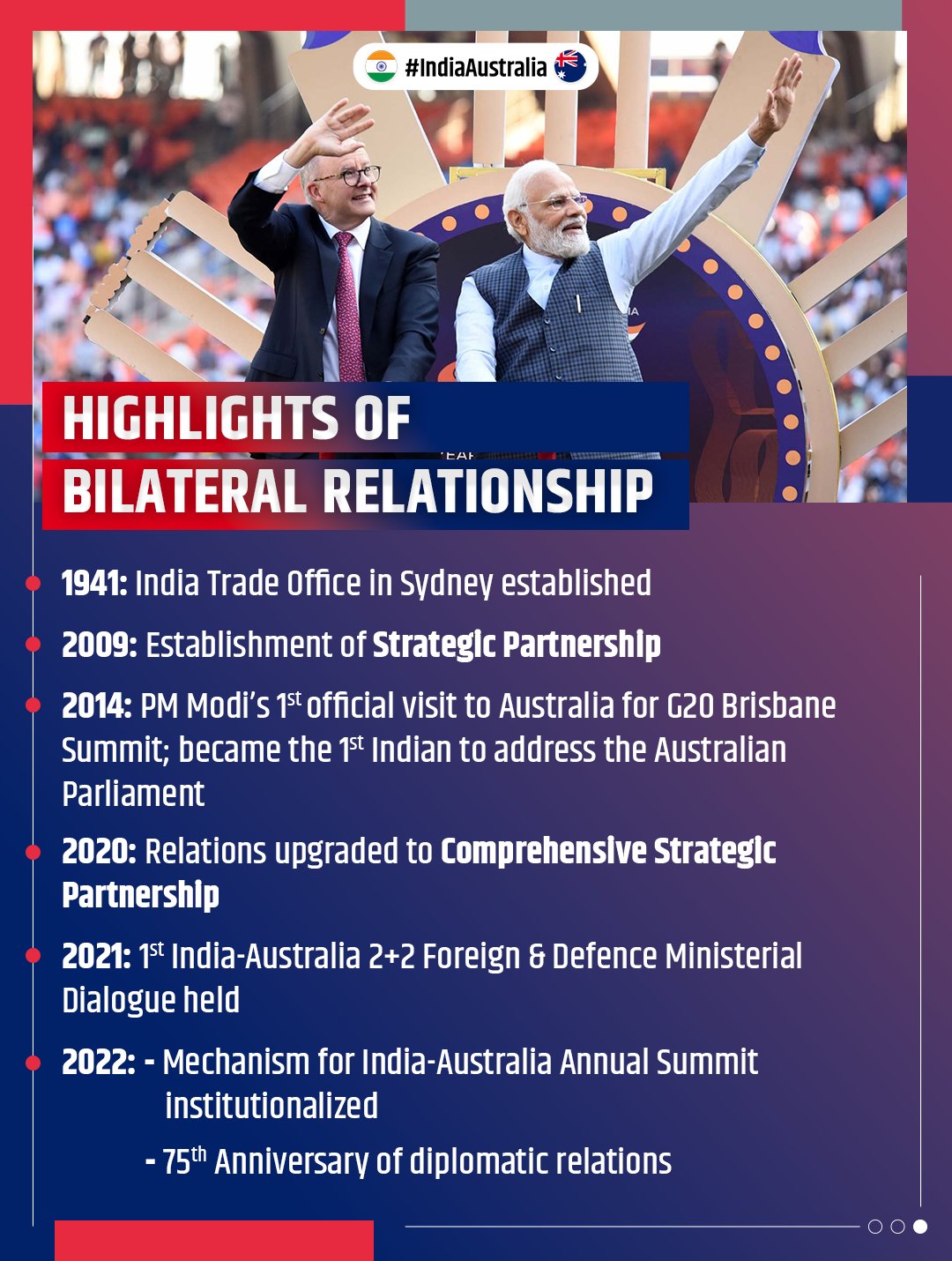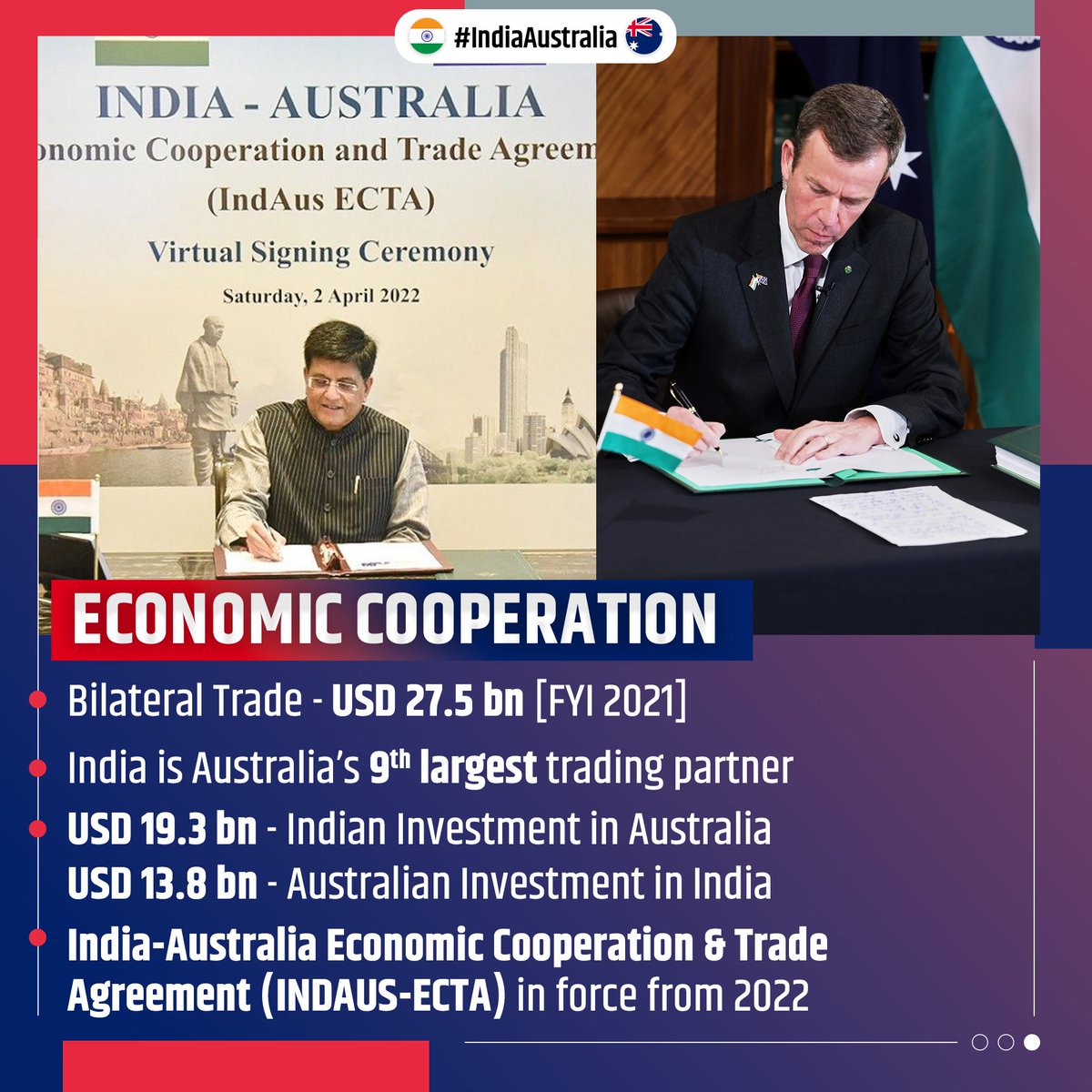ForumIAS announcing GS Foundation Program for UPSC CSE 2025-26 from 19 April. Click Here for more information.
ForumIAS Answer Writing Focus Group (AWFG) for Mains 2024 commencing from 24th June 2024. The Entrance Test for the program will be held on 28th April 2024 at 9 AM. To know more about the program visit: https://forumias.com/blog/awfg2024
Contents
- 1 Introduction
- 2 What are key discussions in the recent Australian Prime Minister (PM) visit to India?
- 3 About the evolution of India-Australia relations in the past
- 4 What is the significance of Australia to India and vice versa?
- 5 What are the areas of cooperation in India-Australia Relations?
- 6 What are the challenges in India-Australia Relations?
- 7 What can be done to strengthen India-Australia Relations?
| For 7PM Editorial Archives click HERE → |
Introduction
The Australian Prime Minister (PM) is on a trip to India. During his visit, India and Australia signed an Audio-visual co-production agreement. The two Prime Ministers also discussed a range of domains to improve India-Australia relations. But to realise the full potential of India-Australia relations few concerns have to be addressed.
What are key discussions in the recent Australian Prime Minister (PM) visit to India?
– Australia wants to work with India and build a relationship in the areas of culture, economics, and security.
-Both countries signed memorandums of understanding (MoUs) for sports and audio-visual co-production agreements, and they also talked about the terms of reference for the Solar Taskforce between India and Australia.
India was worried about the damage done to Hindu temples in Australia by people who support the Khalistani government. In reply, Australia agreed to protect and keep safe the Indian community in Australia.
About the evolution of India-Australia relations in the past

Pre-Independence ties: India and Australia’s relations started immediately after European arrival in Australia in 1788. All trade to and from the penal colony of New South Wales was controlled by the British East India Company through Kolkata.
Both established diplomatic relations in the pre-Independence period, with the establishment of the India Trade Office in Sydney in 1941. The end of the Cold War and simultaneously India’s decision to launch major economic reforms in 1991 provided the first positive move towards the development of closer ties between the two nations.
Post-Independence ties: With the passage of time, the relationship gained momentum towards a strategic relationship, alongside the existing economic engagement.
Since the elevation of the relationship in 2020, the countries have advanced practical actions on cyber and critical technologies, maritime affairs, defence ties, economic and business links and Quadrilateral cooperation.
The countries have also signed India-Australia Economic Cooperation and Trade Agreement (India-Australia ECTA) in 2022. It is a path-breaking trade agreement for both countries and is expected to enhance bilateral trade.
What is the significance of Australia to India and vice versa?
Indo-Pacific Stability: Both nations aspire to a free, open, inclusive, and prosperous Indo-Pacific. The establishment of QUAD grouping and active participation by both is necessary to counter China’s actions in the region.
Gateway to Pacific Countries: The growing cooperation would help India get better access to Pacific Island nations like Kiribati, Solomon Islands etc. as Australia enjoys a high degree of influence over them.
Indian Diaspora: As per the Australian Bureau of Statistics’ 2016 census, 619,164 people in Australia declared that they were of ethnic Indian ancestry which made 2.8% of the Australian population. This huge number induces India to work in tandem with Australia for ensuring their well-being and development.
Upholding International Law: Both nations have a firm commitment to a rule-based international order. They believe in sovereign equality of nations and progression based on mutual respect and understanding.
Geo-Strategic Considerations: Considering Australia’s proximity with the Indian Ocean, active engagement is desired for maintaining India’s strong position in the Indian Ocean region. Further, Australia’s support is desired for getting membership in the Nuclear Suppliers Group and bringing reforms to UNSC.
Energy security: Australia’s long-term and secure LNG supply can help diversify India’s current highly concentrated import supplies from the Middle East.
Defying China: Australia is fully aware of China’s desire to become the dominating force in the Indo-Pacific region. They are also aware of China’s use of economic coercion and its goal to restore the Middle Kingdom. All of this is causing other countries like Australia to balance and restrain China. And India is seen as a key component in these initiatives.
| Read more: India-Australia Bilateral Relationship – Explained, pointwise |
What are the areas of cooperation in India-Australia Relations?

Comprehensive strategic partnership: In 2020, the Prime Ministers of both the countries elevated bilateral relationship from “strategic partnership” to “comprehensive strategic partnership” during the India-Australia Leaders’ Virtual Summit.
Defence Cooperation:
- The 2+2 Ministerial Dialogue between India and Australia took place in 2021. The Mutual Logistics Support Agreement (MLSA) was signed during the Virtual Summit in 2020 to enhance defence cooperation.
- Joint military exercises: In 2023, India, Japan, and the US will all take part in the “Malabar” exercises, which will be held in Australia. India has been invited to join the Talisman Sabre exercises in 2023.
Educational cooperation:
- The Australia-India education qualification recognition mechanism was signed in 2023. This new mechanism will mean that degrees obtained in Australia will now be recognised in India, and, vice-versa.
- Two Australian government universities, Deakin University and University of Wollongong, will be the first foreign education institutions to set up campuses in GIFT City, Gujarat
Economic Cooperation:
- Bilateral trade between the two countries stood at about US$ 27.5 billion in FY 21.
- India-Australia Economic Cooperation Trade Agreement (ECTA) was in force since 2022. This has resulted in an immediate reduction of duty to zero on 96% of Indian exports to Australia in value (that is 98% of the tariff lines) and zero duty on 85% of Australia’s exports (in value) to India.
Security Cooperation: India and Australia are both members of the Quad (Quadrilateral Security Dialogue) along with the US and Japan. Further Australia participated in the 2020 and 2021 editions of the Malabar Naval exercise.
Energy Cooperation:
- A Civil Nuclear Cooperation Agreement between the two countries was signed in 2014. The agreement provides the framework for substantial new trade in energy between Australia and India.
- In 2022, both countries signed a Letter of Intent on New and Renewable Energy for cooperation to reduce the cost of renewable energy technologies, including ultra low-cost solar and clean hydrogen.
- India announced Australian Dollars(AUD) 10 million for Pacific Island Countries under the International Solar Alliance (ISA).
Multilateral cooperation:
- Both are members of the Quad, Commonwealth, Indian Ocean Rim Association (IORA), ASEAN Regional Forum, and Asia Pacific Partnership on Climate and Clean Development, and have participated in the East Asia Summits.
- Both countries have also been cooperating as members of the Five Interested Parties (FIP) in the World Trade Organization context.
- Australia is an important player in Asia Pacific Economic Cooperation (APEC) and supports India’s membership in the organisation.
- Supply Chain Resilience Initiative (SCRI): India, Australia, and Japan collaborated to strengthen Indo-Pacific supply chains.
Science and Technology: Australia-India Strategic Research Fund (AISRF) is a pillar of collaboration on science, technology and research. Both countries successfully conducted the 2021 India Australia Circular Economy Hackathon. Australia is also supporting India’s Gaganyaan Space Program.
People to People Ties: Australia is investing in India’s talented young people through a new Future Skills Initiative between education and training providers and industry. This complements the Australian government’s significant new Maitri scholarships and fellowships which gives Indian students and researchers the chance to experience Australia’s world class education system.
Cultural Cooperation: Australia’s Indigenous peoples are custodians of the oldest continuing civilisation in the world. This is the reason the Australian government returned 29 culturally significant artefacts to India.
What are the challenges in India-Australia Relations?
Coal mine controversy: There was controversy over the Adani coal mine project in Australia, with some activists protesting against it, which created a strain in the relationship between the two countries.
Visa issues: There have been concerns over visa restrictions for Indian students and professionals seeking to work in Australia.
India’s stand on the Russia-Ukraine crisis: Australia has criticized the Russian invasion of Ukraine and sided with the U.S. and western countries. However, India has refrained from criticizing Russia over the issue. This can create differences in bilateral discourse and the functioning of QUAD.
No Free Trade Agreement: Both nations have been interacting and communicating with each other for decades but have failed to create a consensus on a Free trade agreement.
China’s Discontent: China is unhappy with the growing security cooperation between Australia and India. The Chinese government responded to the Quadrilateral dialogue by issuing formal diplomatic protests to its members, calling it “Asian NATO”.
Lack of Uranium Supply: The progress on uranium supply has been very low, despite efforts from both sides. In 2017, Australia had sent its first uranium shipment to India but that was cited as “a small sample of uranium” transferred “purely for testing purposes”.
Violence with Indian Diaspora: Attacks on Indian Diaspora and temples in the recent past by Khalistan supporters have been an issue of strain.
What can be done to strengthen India-Australia Relations?
Focus on economics competitiveness: India would have to work on improving its competitiveness, as in most trade sectors, it would be competing with China, ASEAN, Chile, Japan, Korea and New Zealand, which have already-functional FTAs with Australia. Australia has 16 FTAs under operation.
Reduce religious polarisation in India: Like India raised objections about Khalistani groups and their attack on temples in Australia, India should reduce religious polarisation within the country.
Active diplomatic engagement: It would be required to make Australia fulfil its promise to amend its domestic tax law in order to stop taxation of the offshore income of Indian firms providing technical services to Australia.
Collaborate on Science & Technology: India and Australia have a strong track record of collaborating in research and innovation. The Australian Government’s $1.1 billion National Innovation and Science Agenda presents new opportunities to engage with India. The agenda resonates well with India’s ‘Start-up India’ and ‘Make in India’ campaign.
Encourage cooperation in Space: India can provide commercial Space applications to Australia for several of its Space initiatives.
Focus on common interests: Regular strategic dialogue should focus on common interests, including those relating to China, Pakistan, Afghanistan, terrorism and maritime security. A bilateral security declaration is needed between Australia and India. India should reciprocate Australia’s overtures to engage as a priority maritime partner.
| Read more: Indo-Australian relationship. How bilateral relations among two nations can be strengthened? |
Sources: DFAT, MEA, Indian Express (Article 1 and Article 2), The Hindu(Article 1 and Article 2)
Syllabus: GS 2: International Relations – Bilateral, regional and global groupings and agreements involving India and/or affecting India’s interests.




